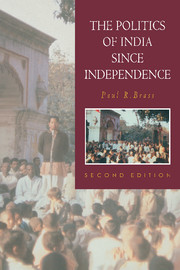Book contents
- Frontmatter
- Dedication
- CONTENTS
- List of figures and tables
- Preface
- List of abbreviations
- 1 Introduction: continuities and discontinuities between pre- and post-Independence India
- PART I POLITICAL CHANGE
- PART II PLURALISM AND NATIONAL INTEGRATION
- Introduction
- 5 Language problems
- 6 Crises of national unity: Punjab, the northeast, and Kashmir
- 7 Communal and caste conflict: secularism, Hindu nationalism, and the Indian state
- PART III POLITICAL ECONOMY
- Bibliography
- Index
5 - Language problems
Published online by Cambridge University Press: 05 February 2015
- Frontmatter
- Dedication
- CONTENTS
- List of figures and tables
- Preface
- List of abbreviations
- 1 Introduction: continuities and discontinuities between pre- and post-Independence India
- PART I POLITICAL CHANGE
- PART II PLURALISM AND NATIONAL INTEGRATION
- Introduction
- 5 Language problems
- 6 Crises of national unity: Punjab, the northeast, and Kashmir
- 7 Communal and caste conflict: secularism, Hindu nationalism, and the Indian state
- PART III POLITICAL ECONOMY
- Bibliography
- Index
Summary
India's national leaders had to confront several language problems in the first two decades of Independence and what appeared to some of them in the aftermath of Partition to be a real threat of the “Balkanization” of the country. These problems included the official language issue, demands for the linguistic reorganization of the provinces of India whose boundaries during British rule did not conform to linguistic divisions, and the status of minority languages within reorganized states. Most of the language conflicts in the Nehru period, some of which became at times bitter and violent, were ultimately resolved through pluralistic solutions. The central government and the national leadership of the Congress sought to avoid direct confrontations with the language movements and their leaders and adopted instead arbitrating and mediating roles wherever possible. In the case of the movements for linguistic reorganization of states, until mutual agreements were reached among contending language groups and their leaders, the Center attempted to ensure that the state governments were under the control of strong leaders whom it supported in efforts to maintain civil order.
In the post-Nehru period, however, several linguistic, ethnic, and regional movements have escalated to levels of bitterness and violence never experienced in the Nehru period except in the tribal regions of the northeast. It will be argued in the following chapter that the centralizing drives of the Indian state under Mrs. Gandhi's leadership and the manipulative and interventionist strategies pursued by the central government and its leaders in state politics have contributed to the intensity of such conflicts during the past two decades. Most of the problems discussed in this chapter, however, were resolved during the Nehru period and will provide a base for comparison with the unresolved problems which have persisted into the 1980s and 1990s.
THE OFFICIAL LANGUAGE PROBLEM
Before independence, the most salient language issue in Indian politics concerned the relative positions of Hindi and Urdu and of the Devana-gari and Persian-Arabic scripts.
- Type
- Chapter
- Information
- The Politics of India since Independence , pp. 157 - 191Publisher: Cambridge University PressPrint publication year: 1994

